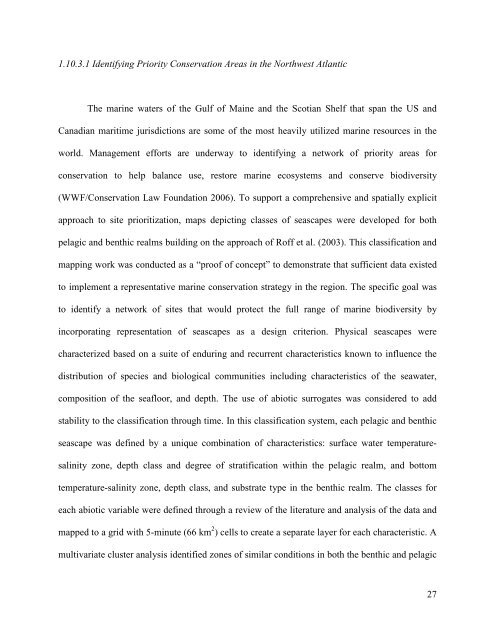1 1.10 Application of estuarine and coastal classifications in marine ...
1 1.10 Application of estuarine and coastal classifications in marine ...
1 1.10 Application of estuarine and coastal classifications in marine ...
Create successful ePaper yourself
Turn your PDF publications into a flip-book with our unique Google optimized e-Paper software.
<strong>1.10</strong>.3.1 Identify<strong>in</strong>g Priority Conservation Areas <strong>in</strong> the Northwest Atlantic<br />
The mar<strong>in</strong>e waters <strong>of</strong> the Gulf <strong>of</strong> Ma<strong>in</strong>e <strong>and</strong> the Scotian Shelf that span the US <strong>and</strong><br />
Canadian maritime jurisdictions are some <strong>of</strong> the most heavily utilized mar<strong>in</strong>e resources <strong>in</strong> the<br />
world. Management efforts are underway to identify<strong>in</strong>g a network <strong>of</strong> priority areas for<br />
conservation to help balance use, restore mar<strong>in</strong>e ecosystems <strong>and</strong> conserve biodiversity<br />
(WWF/Conservation Law Foundation 2006). To support a comprehensive <strong>and</strong> spatially explicit<br />
approach to site prioritization, maps depict<strong>in</strong>g classes <strong>of</strong> seascapes were developed for both<br />
pelagic <strong>and</strong> benthic realms build<strong>in</strong>g on the approach <strong>of</strong> R<strong>of</strong>f et al. (2003). This classification <strong>and</strong><br />
mapp<strong>in</strong>g work was conducted as a “pro<strong>of</strong> <strong>of</strong> concept” to demonstrate that sufficient data existed<br />
to implement a representative mar<strong>in</strong>e conservation strategy <strong>in</strong> the region. The specific goal was<br />
to identify a network <strong>of</strong> sites that would protect the full range <strong>of</strong> mar<strong>in</strong>e biodiversity by<br />
<strong>in</strong>corporat<strong>in</strong>g representation <strong>of</strong> seascapes as a design criterion. Physical seascapes were<br />
characterized based on a suite <strong>of</strong> endur<strong>in</strong>g <strong>and</strong> recurrent characteristics known to <strong>in</strong>fluence the<br />
distribution <strong>of</strong> species <strong>and</strong> biological communities <strong>in</strong>clud<strong>in</strong>g characteristics <strong>of</strong> the seawater,<br />
composition <strong>of</strong> the seafloor, <strong>and</strong> depth. The use <strong>of</strong> abiotic surrogates was considered to add<br />
stability to the classification through time. In this classification system, each pelagic <strong>and</strong> benthic<br />
seascape was def<strong>in</strong>ed by a unique comb<strong>in</strong>ation <strong>of</strong> characteristics: surface water temperaturesal<strong>in</strong>ity<br />
zone, depth class <strong>and</strong> degree <strong>of</strong> stratification with<strong>in</strong> the pelagic realm, <strong>and</strong> bottom<br />
temperature-sal<strong>in</strong>ity zone, depth class, <strong>and</strong> substrate type <strong>in</strong> the benthic realm. The classes for<br />
each abiotic variable were def<strong>in</strong>ed through a review <strong>of</strong> the literature <strong>and</strong> analysis <strong>of</strong> the data <strong>and</strong><br />
mapped to a grid with 5-m<strong>in</strong>ute (66 km 2 ) cells to create a separate layer for each characteristic. A<br />
multivariate cluster analysis identified zones <strong>of</strong> similar conditions <strong>in</strong> both the benthic <strong>and</strong> pelagic<br />
27
















